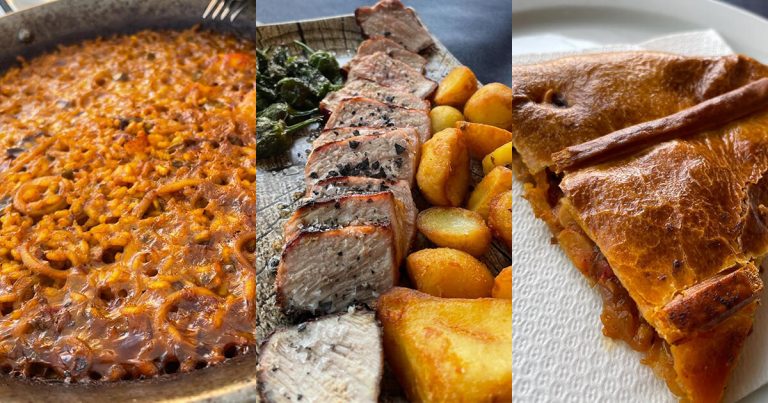Senoritas and caballeros, foodies and taste buds, welcome to a culinary showdown that can only end with a resounding “Ole!”. In the yellow and red corner, we present Madrid cuisine from the bustling capital, a heavyweight champion known for its hearty dishes and urban atmosphere. In the white and blue corner, we present Galician cuisine from the misty green coast of the northwest, a veteran cuisine with salty flavors and rustic charm. So eat and see who will be crowned!
Round 1: Starters
Forget about tapas, which can be found in any modern metropolis. These little dishes like croquetas, patatas bravas, and chorizo al vino have the power to turn a casual bar outing into a gourmet adventure. But for an appetizer that can be a meal in itself, try the Tortilla de Patatas at Casa Dani, preferably in the heart of Madrid’s world-famous Mercado de la Paz. In the Americas, a tortilla is a round, thin flatbread made from unleavened cornmeal, wheat flour, or agave. But in the Iberian Peninsula, a tortilla de patatas is a potato omelette, with or without onions. When trying it at home, add ham and cheese. It’s a tasty dish and packs quite a punch.
In Galicia, pulpo a la gallega is a popular dish – melt-in-your-mouth tender octopus served on a wooden plate with a sprinkling of paprika, sea salt and a little olive oil. It’s available all over the region, but Pulperia a Garnacha in Melide, halfway between Parras del Rey and Arzua, serves the best version of this traditional favourite. It’s a dish that’s simple yet sensational. The tapas and tortillas are a must-try!
Urnedo de Cerdo Iberico – Tender grilled pork sprinkled with sea salt and secret spices, served with baby potatoes and sweet peppers Round 2: Main
Enter Madrid’s specialty, paella: a pan-steamed dish of sticky rice mixed with saffron, various seafood, chickpeas, meat and vegetables. It’s the Spanish equivalent of a warm hug from your grandma. Like the tortilla, paella is a rich and hearty meal in itself; some cafeterias even sell it in small portions.
Caldo Gallego is a hearty soup with vegetables, white beans, potatoes, chorizo and pork.
Galicia strikes back with unstoppable combinations: caldo gallego, a hearty soup loaded with vegetables, potatoes, chorizo and pork; empanadas gallegas, savory pies stuffed with tuna, cod, octopus or meat (I had the empanadas artesana gallega de pulpo, and every bite tasted heavenly); and tournedo de cerdo ibérico (turned Iberian pork), tender grilled pork sprinkled with sea salt and secret spices and served with baby potatoes and sweet peppers (so tasty!). These dishes are hearty, just like cozy evenings spent beside the Atlantic waves.
Empanada artesana gallega de pulpo (Empanada stuffed with octopus) Round 3: Seafood
Madrid being a landlocked country might seem a disadvantage here, but in return comes the bacalao gratinado (phew!), a grilled cod gratin served on peppers with a sweet aioli. I had this amazing dish with my niece and her boyfriend in Plaza Mayor, the tourist hub of the city, and I definitely want to try it. Note: portions are small, so don’t share. Not bad, Madrid, not bad at all.
Perfectly grilled vieiras (scallops) drizzled in EVOO and garnished with sweet aioli, the baked cod gratin “Bacalao gratinado con all i oli dulce sobre pimientos a la llama” is a dish that offers a multitude of flavours.
But Galicia is the Muhammad Ali of seafood, a seafood lover’s dream come true, with scallops wrapped around a scallop tucked into a shell, fluttering like a butterfly and stinging like a bee. I asked if they used butter in my dish. “No butter, senor. Just butter.” Thanks to four years of Spanish in high school and 12 credits in college, I understood perfectly. Their extra virgin olive oil is of course the finest, but a touch of garlic would have been perfect for my Filipino palate. Scallops are, needless to say, one of the symbols of the Camino de Santiago. Pilgrims and pagans alike could be whipped if they didn’t eat them at least once in Galicia.
Round 4: Sweets Churros con chocolate – Churrerias all over the city
Aside from turrón (a nougat confection that’s a denture wearer’s nightmare) and violeta (a violet-coloured candy shaped like a chocolate), Madrid achieves a two-for-one combo: churros con chocolate: three to five churros (or two to three porras, or lighter, extra-large churros) on offer at any one time in countless churrerias should be enough to drink down the entire contents of a cup of the richest chocolate on earth, which can be spelled “decadence.”
Churros con chocolate – Churrerias on every corner
Galicia delivers a knockout punch with tarta de Santiago, an almond cake dusted with powdered sugar and decorated with the cross of St. James. It’s rich, flavoursome and has a history as deep as the Camino de Santiago. Lo siento señor, pero los churros con chocolate tienen mi voto. (Sorry, but I vote for churros and chocolate.) In Galicia, this is one way of picking a fight.
Tarta de Santiago—Looks good, tastes bad Verdict
In the end, it’s not who wins or loses that matters, but the treats enjoyed along the way. Madrid’s cuisine is a vibrant mix of influences, perfect for those who love diversity and urban sophistication, while Galicia’s cuisine is a love letter to the sea and land, perfect for those who love the raw, pure flavors of nature.
Whether you’re sipping vermouth in Madrid or tasting pulpo in Galicia, you’re in for a treat, because the real winner in this delicious duel is you, the lucky eater: Bon appetit, or “Buen Provecho” as they say in Spain.


